Overview
[ Top
| Version B
| Version C
| Return to Misc. Descenders
]
Version A
(#1025)
Technical Details
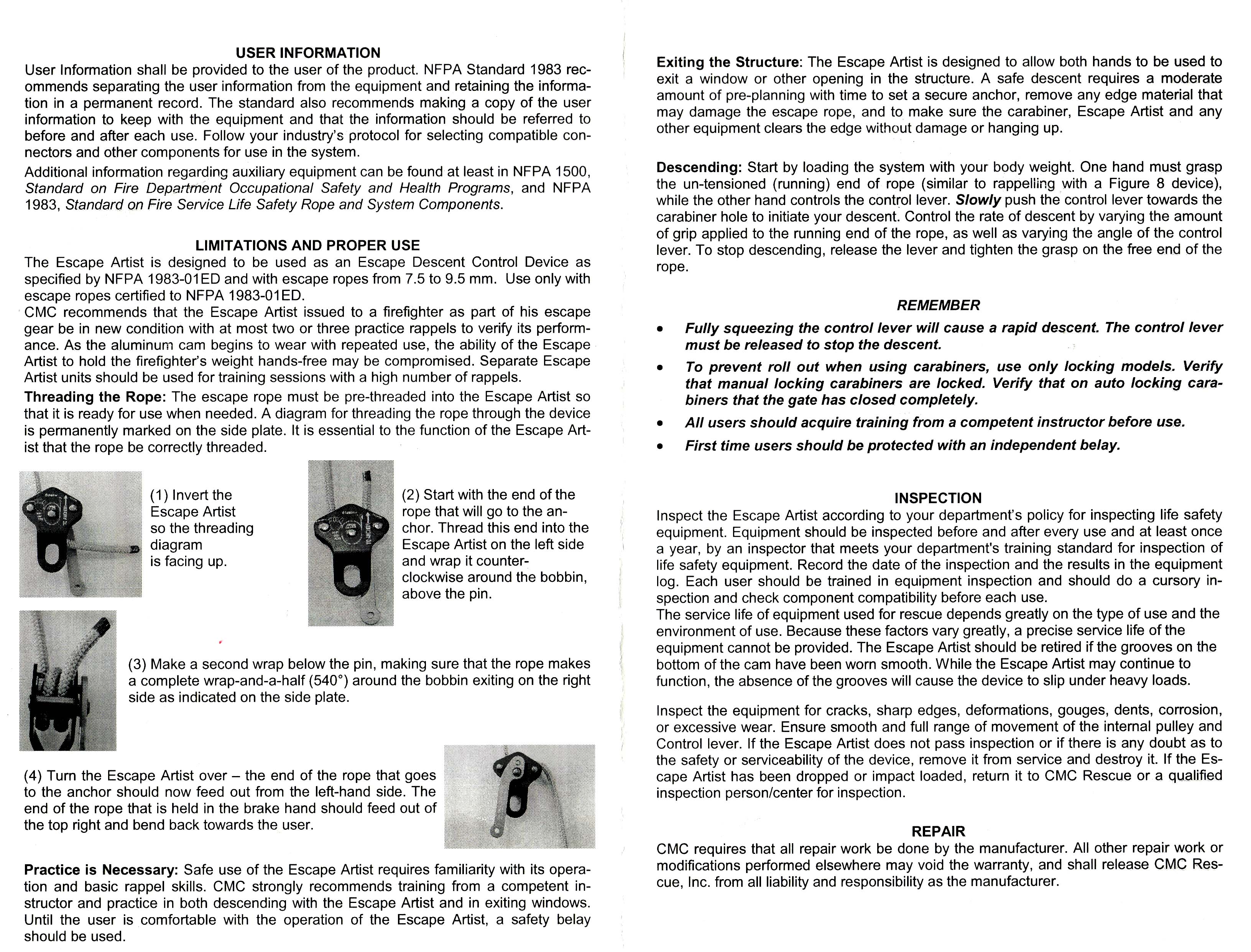 I acquired my CMC Rescue Escape Artist from Rescue Response
Gear in 2006.
I acquired my CMC Rescue Escape Artist from Rescue Response
Gear in 2006.
The CMC Rescue Escape Artist, Version A is 101 mm.
tall, 70 mm. wide, and 41 mm. thick. Mine weighs 145 g.
This Rescue Escape Artist consists of a pivoting, lever-actuated,
oval spool fitted between two side plates. The side plates are
2.5 mm. anodized aluminum. The side plates are shaped much
like inverted rescue pulley side plates, including a 24 mm.
high, 16 mm. wide oval hole at the bottom of each for rigging,
and two bends each to bring the plates together at the rigging
hole. The plates are rigidly connected by two 9.5 mm. riveted
bars, one at each side. The spool and lever are mounted on a hollow
steel shaft that penetrates the rear plate. A third bar riveted
to the center of the front plate passes through a hollow bar.
The rear plate has an additional cut to provide clearance for
a second pin connecting the spool and release lever.
The spool is 28.7 mm. high by 19.2 mm. wide oval-shaped
aluminum block. The block appears to be extruded. It has shallow
grooves at the lower left and right, while the top is semicircular.
The block is free to rotate on the shaft to about 60° to one
side of center. A 3.2 mm. stainless steel pin protrudes 9 mm.
from each side of the spool.
The release lever is made from 4.1 mm. anodized aluminum.
The front plate is printed with "Ø 7.5-9.5mm,"
"PATENTED," an illustration of the rope path complete
with an arrow labeled "TO ANCHOR" and a hand labeled
"MUST GRIP ROPE." the "Reading
is Dangerous" icon, and "LOT# A001." The lever
is printed with "CMC RESCUE ESCAPE ARTIST™," "MEETS
NFPA 1983 (2001 ED.) E MBS 13.5kN," the Underwriters Laboratories
Classified logo, and a semicircular double-ended arrow around
the pivot with one end labeled "GO" and the other "STOP."
The CMC Rescue Escape Artist came without any instructions
(so what is the "Reading
is Dangerous" icon supposed to mean?), but there is some
information available on the CMC
web site.
The Rescue Escape Artist does not open for rigging, so the
user must have access to a free end of the rope. This means that
the device should be pre-rigged if one intends to have it available
in emergency situations. Rigging consists of putting two wraps
around the spool. The device is not symmetrical so the rigging
must follow the illustration on the front of the device.
The instructions state that one controls the descent using
both the lever and a braking hand. The lever is too sensitive
for my taste, especially on smaller ropes. Squeezing the lever
fully decreases friction dramatically - there is no "panic
safety" feature. The Rescue Escape Artist will provide an
autostop feature if one lets go. I don't like this on any device,
for a variety of reasons.
The Rescue Escape Artist is designed for firefighters. I avoid
burning buildings myself, so I'll let people who don't write their
own web sites to tell about its use in that environment. For cavers
and climbers, it is too small for ropes over 9.5 mm. and
too complex.
The Rescue Escape Artist was clearly motivated by the Traverse
Rescue 540° Rescue Belay, which CMC now sells as well. The Sterling PDQ is similar to the Rescue Escape Artist. U.S. Patent #6,378,650 listed on the rear of the Sterling PDQ clearly illustrates the Traverse
Rescue 540° Rescue Belay, supporting the relationships.
|
 |
Another Viewpoint and a Warning |
 |
|
On the home
page I state. "I don't run into burning buildings to
jump out the windows, I don't play Tarzan of the jungle, and
I no longer actively interfere with natural selection. I have no objection
to anyone doing these things, but I don't have those forms of
experience. If you do any of these, you should form your own
opinions." William Voorhies is one of those people, so
after exchanging emails with me, he tested the Rescue Escape
Artist to form his own opinions. He had results that I didn't.
In August 2008, he sent me a short note that contained the following
paragraphs:
I purchased the descender not long after
we first spoke and was able to test it early June. I had pre-rigged
it on my escape line and kept it in a bag attached to my harness
for quick deployment.
For the test I was descending out of
a third story window in full fire fighting gear. I realized quickly
just how right you were about how sensitive the actuating lever
is. The descender worked well for the first three tests. But
the fourth test was a disaster. Because of how the descender
is designed with a pin to separate the rope as it feeds through
the device, it locked up on me. You see, while it was in my bag,
prior to deployment, the arm was moved and the rope slid over
in front of the pin. When I exited the window and put my weight
on the line, the pin came down and pierced the outer jacket of
the rope. The only way to descend would then have been to raise
all of my weight off of the device, unhook my rope from the pin
and then proceed. Something I wasn't able to do. Good thing I
was belayed.
I asked if I could use his note here, and he offered to send
more details and some pictures. Here is how he tested the device.
First, note that he had a belay during the test, in case anything
went wrong. Next, note that crawling out a window in full turnout
gear is not the ideal way to start a rappel (and this building
isn't even burning). It is easy to get things rearranged in places
you don't want them to be (of course, that happens in caves as
well).
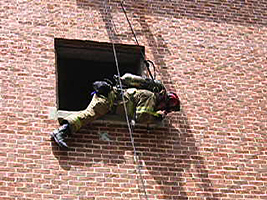
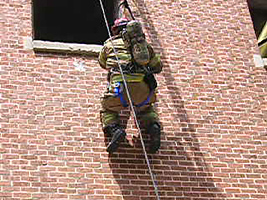
Now for his expanded description of what happened:
The CMC Rescue Escape Artist Descender
is marketed as a comparable alternative to the Petzl EXO Escape
System which is currently the premiere firefighter self-rescue
system on the market now. A firefighter escape system must be:
- Quick to deploy [thirty seconds with
fire at your back is an eternity]
- Simple to use [in zero visibility and
with thick fire fighting gloves on]
- Always ready [incorporated into a firefighter’s
equipment so that it isn't an option to put it on].
I purchased a CMC Rescue Escape Artist
(REA) descender and was able to borrow a Petzl EXO Escape System
for practical testing. Aside from obvious mechanical differences
in their construction, their actions were very similar, until
the last test. I performed six "bail-outs" from a third
story window at our fire academy; three for each system. For
the sake of comparison I pre-rigged the CMC RAE with 7.5 mm.
NFPA Soft Escape Tech Lifeline rope and the Crosby Hook anchor
that the Petzl system uses (the Crosby Hook allows a firefighter
to use a windowsill as an anchor.)
On the last bail-out test the rope crossed
within the CMC RAE and moved in front of one of the pins on the
bobbin. This apparently happened while the device and rope were
stored in my deployment bag prior to use. As you can see in the
following pictures the pin is then in a position to penetrate
the outer sheath. When the system was loaded with my weight,
the pin effectively locked the system up. To free my rope I would
have had to take all of the load off of the device, something
I was obviously unable to do (in full gear I weigh in at around
300 lbs.)
I believe this is a serious problem
with the CMC RAE for persons intending to use it for firefighter
self rescue. While the version of the device I own is no longer
offered on the CMC website, their literature for the updated
devices indicate that they include these pins as part of their
mechanism. It is possible that the CMC RAE works better with
the rope they sell with it as part of their system. However,
this is not a stipulation that I could find on the device or
any of it’s accompanying literature. The Petzl EXO mechanism,
in contrast, has been tested by FDNY [Fire Department of New
York] over 10,000 times during which they were only able to make
it fail once (subsequently a slight design modification was made.)
Bill provided these pictures to illustrate what happened.
Ouch! To a caver hanging in a waterfall (with a couple ascenders),
this would be a nuisance; for a fireman trying to get off a burning
building before the rope melts, I can only imagine it
as a nightmare.
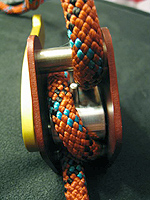
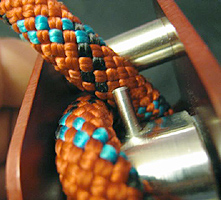
As a bit of trivia,
before Petzl developed the EXO for the FDNY, the FDNY contacted
me to see if I could recommend a device that met a certain list
of requirements that they had developed. At the time, there was
no such device on the market, at least not to my knowledge.
Bill, thank you for taking
the time to prepare a writeup for this site!
[ Top
| Version A
| Version C
| Return to Misc. Descenders
]
Version B
(#1155)
Technical Details
 I acquired my CMC Rescue Escape Artist from Rescue response
Gear in 2008.
I acquired my CMC Rescue Escape Artist from Rescue response
Gear in 2008.
The CMC Rescue Escape Artist, Version B is 117 mm.
tall, 72 mm. wide, and 37 mm. thick. Mine weighs 145 g.
It is similar to Version A, so I'll give the description
in gray and use black to indicate
changes made in Version B.
This Rescue Escape Artist consists of
a pivoting, lever-actuated, oval spool fitted between two side
plates. The side plates are 2.5 mm. anodized aluminum. The
side plates are shaped much like inverted rescue pulley side plates,
including a 24 mm. high, 16 mm. wide oval hole at the
bottom of each for rigging, and two bends each to bring the plates
together at the rigging hole. The plates are rigidly connected
by two 9.5 mm. riveted bars, one at each side, and
a third, 14 mm. steel shaft that acts as an axle for a central
spool.
The spool is 28.7 mm. high by 19.2 mm.
wide oval-shaped aluminum block. The block appears to be extruded.
It has shallow grooves at the lower left and right, while the
top is semicircular. The block is free to rotate on the shaft
to about 60° to one side of center. A 3.2 mm. stainless
steel pin protrudes 9 mm. from each side of the spool.
The release lever is made from a 108 mm.
long, 12.6 mm. square, anodized
aluminum bar. It pivots on one of the side bars between
the plates. A 35 mm. long, 12 mm. wide, and 3.5 mm
thick aluminum bar connects the upper end of the release lever
with the upper end of the spool. These attachments are loosely
pinned. The release lever has six 4.8 mm. lightening holes
drilled along its length.
The rear
plate is printed with "LOT NO 5397,"
"Ø 7.5-9.0mm,"
an illustration of the rope path complete with an arrow labeled
"TO ANCHOR" and a hand labeled "MUST GRIP ROPE."
the "Reading is Dangerous" icon, and "ESCAPE ARTIST™." The front plate
is printed with "CMC RESCUE,"
the Underwriters Laboratories Classified logo, "5F04,"
"PATENTED," and"MEETS NFPA
1983 (06 ED.)E MBS 13.5kN."
I prefer the lever arrangement on Version B to that on
Version A. Not only is the lever larger and easier to use, but
it is also more robust and in a more protected location. Version B
is larger and heavier than Version A, but this is mainly
because of the sturdier control lever. For some reason, CMC reduced
the recommended rope sizes as well.
[ Top
| Version A
| Version B
| Return to Misc. Descenders
]
Version C
(#1165)
Technical Details
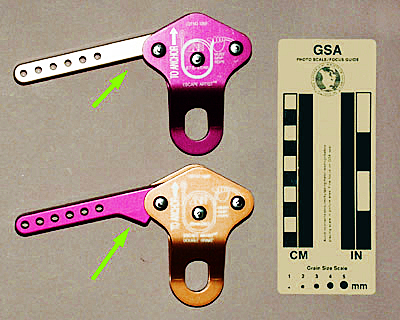 I acquired my CMC Rescue Escape Artist, Version C (Double
Brake) from Rescue Response Gear Inc. in 2008. Version C
is 113 mm. tall, 71 mm. wide, and 38 mm. thick. Mine
weighs 189 g.
I acquired my CMC Rescue Escape Artist, Version C (Double
Brake) from Rescue Response Gear Inc. in 2008. Version C
is 113 mm. tall, 71 mm. wide, and 38 mm. thick. Mine
weighs 189 g.
Version C is similar to Version B, the difference
being that the release lever on Version C has a small triangular
extension on the inside (see the arrows in the comparison picture).
This extension presses against the rope when the rappeller squeezes
the release lever too far.
The markings on Version C are slightly different as well.
The rear plate is printed with "LOT NO 5561,"
"Ø8mm ONLY," an illustration of the rope path complete
with an arrow labeled "TO ANCHOR" and a hand labeled
"MUST GRIP ROPE." the "Reading
is Dangerous" icon, "ESCAPE
ARTIST™," and "DOUBLE
BRAKE." The front plate
is printed with "CMC RESCUE," the Underwriters Laboratories
Classified logo, "5F04," "PATENTED," and"MEETS
NFPA 1983 (06 ED.)E MBS 13.5kN."
While Versions A & B have no "panic safety"
feature, Version C adds a "panic safety" feature.
I don't like these sorts of things on any device, for a variety
of reasons, but I have to admit that CMC found a clever way
to add this by a minor modification of a single part. Unfortunately,
dimensions are critical so it only works on one particular rope
diameter, 8 mm. I consider that too thin for general use,
but for emergencies, I’d trust it if I had to. Personally, I’d
rather use a normal rope/descender combination.
[ Top
| Version A
| Version B
| Version C
]




